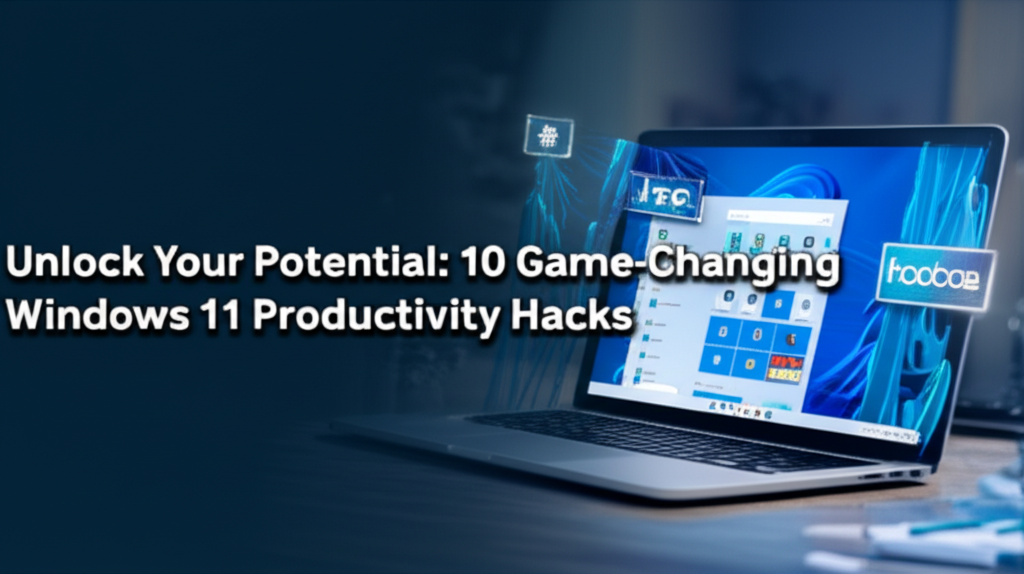Introduction
Windows 11 is designed not only to look stunning but also to enhance user productivity. In our fast-paced digital world, making the most of your operating system is crucial for both personal and professional success. Whether you’re a student trying to manage assignments, a professional juggling multiple tasks, or someone simply looking to optimize your daily routine, Windows 11 offers a range of features that can greatly enhance your workflow.
This guide will walk you through ten invaluable productivity hacks that will unlock your potential. From built-in features to alternative software recommendations, each section will equip you with practical knowledge, troubleshooting tips, common errors, and even advanced tweaks. By the end of this article, you’ll be on your way to maximizing your efficiency on Windows 11, regardless of your technical expertise.
1. Snap Layouts and Snap Groups
Why It Matters
Understanding how to manage your windows efficiently can transform your multitasking capabilities. Snap Layouts and Snap Groups make it easy to organize your desktop and switch between tasks seamlessly.
Instructions
-
Access Snap Layouts: Hover your mouse over the maximize button of any window. You’ll see various layout options pop up.
-
Select a Layout: Click on the layout you prefer. For example, you can choose a side-by-side view or a grid layout.
-
Snap More Windows: Once the first window is snapped, repeat the same hover-and-click process for additional windows.
- Creating Snap Groups: When you switch between apps, simply hover over the taskbar to view your Snap Groups. Select any of your grouped apps to open them all at once.
Alternative Software Recommendations
- DisplayFusion: Offers advanced multi-monitor support and window snapping features.
- Fancy Zones (from PowerToys): A more customizable setup for window management.
Common Errors and Fixes
- Layouts Not Appearing: Ensure that Snap windows are enabled in settings. Go to Settings > System > Multitasking and toggle on Snap Windows.
Advanced Tweaks
- Use keyboard shortcuts: Press Windows + Z to quickly bring up Snap Layout options.
2. Virtual Desktops
Why It Matters
Virtual desktops are perfect for keeping your work organized. This feature allows you to create separate desktops for different tasks or projects without cluttering a single desktop space.
Instructions
-
Open Task View: Press Windows + Tab to bring up Task View.
-
Create a New Desktop: Click on New Desktop at the top.
-
Switch Between Desktops: Use Windows + Ctrl + Left/Right Arrow to switch between your desktops.
- Move Windows Between Desktops: In Task View, drag a window from one desktop to another.
Alternative Software Recommendations
- Dexpot: A third-party tool that enhances virtual desktop capabilities with additional features.
Common Errors and Fixes
- Desktop Not Switching: If it seems unresponsive, try restarting Task View or your computer.
Advanced Tweaks
- Assign different wallpapers for each desktop for easy identification.
3. Microsoft To Do for Task Management
Why It Matters
Staying organized is vital for productivity. Microsoft To Do is a simple, yet effective task management app that helps you keep track of what needs to be done.
Instructions
-
Install Microsoft To Do: Download from the Microsoft Store if not already installed.
-
Create Your Task List:
- Open Microsoft To Do.
- Click on New List on the left sidebar.
- Name your list and click Create.
-
Add Tasks: Click Add a Task, type your task, and hit Enter.
- Set Reminders and Due Dates: Click on a task and select Add due date or Add Reminder.
Alternative Software Recommendations
- Todoist: Offers robust task management features with integrations to other apps.
- Trello: A visual project management tool that can also help organize tasks efficiently.
Common Errors and Fixes
- Not Syncing Across Devices: Ensure you are logged into the same Microsoft account on all devices.
Advanced Tweaks
- Use My Day to focus on daily tasks for improved productivity.
4. Windows Focus Assist
Why It Matters
Distractions can derail productivity. Windows Focus Assist helps you minimize interruptions by controlling notifications.
Instructions
-
Access Focus Assist: Right-click on the notification icon in the Taskbar and select Focus Assist.
-
Choose Your Settings:
- Priority Only: Only allows notifications from chosen apps.
- Alarms Only: Turns off everything except alarms.
- Set Automatic Rules: Go to Settings > System > Focus Assist to configure automatic activation during specific times or while playing games.
Alternative Software Recommendations
- Cold Turkey Blocker: A comprehensive app blocker that can prevent access to distracting websites.
Common Errors and Fixes
- Notifications Still Appear: Ensure you’ve configured settings correctly and are not on Priority Only without any apps selected.
Advanced Tweaks
- Create custom rules based on your calendar events.
5. Built-in Snipping Tool for Screenshots
Why It Matters
Taking screenshots is essential for capturing information quickly. The built-in Snipping Tool in Windows 11 makes this process straightforward.
Instructions
-
Open Snipping Tool: Press Windows + Shift + S to activate the screenshot tool.
-
Choose Your Snip Type: Select from rectangular, freeform, window, or full-screen snips.
- Save Your Snip: After taking a screenshot, click on the notification to open it in the Snipping Tool, where you can further edit or save it.
Alternative Software Recommendations
- Greenshot: A free tool with additional editing features.
- Skitch: Offers annotation features for your screenshots.
Common Errors and Fixes
- Tool Not Launching: Check if your Windows is up to date since this feature may not function in outdated versions.
Advanced Tweaks
- Use Windows + PrtScn for full-screen captures automatically saved to your Pictures library.
6. OneDrive for Cloud Storage
Why It Matters
Backing up files is crucial for data security. OneDrive allows you to store your files in the cloud and access them from any device.
Instructions
-
Set Up OneDrive: Sign in to your Microsoft account and follow the setup prompts.
-
Sync Folders: Choose which folders you want to sync to your OneDrive.
- Upload Files: Drag files into the OneDrive folder on your PC or upload directly through the OneDrive website.
Alternative Software Recommendations
- Google Drive: Offers substantial free storage and collaboration features.
- Dropbox: Known for its simple interface and robust file-sharing capabilities.
Common Errors and Fixes
- Files Not Syncing: Check your internet connection and ensure that OneDrive is running.
Advanced Tweaks
- Use “Files On-Demand” to save space on your device while keeping files accessible.
7. Windows 11 Clipboard History
Why It Matters
Being able to access your clipboard history means you can copy-paste multiple items rather than just the last one, saving time.
Instructions
-
Enable Clipboard History: Go to Settings > System > Clipboard, and toggle on Clipboard history.
-
Access Clipboard History: Press Windows + V to see your clipboard history.
- Select an Item: Click on any item in the clipboard history to paste it.
Alternative Software Recommendations
- Ditto: An advanced clipboard manager that provides more features.
Common Errors and Fixes
- Clipboard History Not Showing: Ensure that clipboard history is enabled in settings.
Advanced Tweaks
- Sync your clipboard across devices by enabling instant sync.
8. Windows 11 File Explorer Shortcuts
Why It Matters
Efficient navigation within File Explorer can save time, especially if you work with multiple files and folders.
Instructions
-
Use Quick Access: Pin your most-used folders to Quick Access for quicker access.
-
Keyboard Shortcuts:
- Alt + D: Focus on the address bar.
- Ctrl + N: Open a new window.
- Ctrl + W: Close the current window.
- Context Menu Enhancements: Right-click on files to access additional options quickly.
Alternative Software Recommendations
- Directory Opus: A powerful file manager with enhanced features.
Common Errors and Fixes
- File Explorer Crashes: Restart your PC or run sfc /scannow in Command Prompt.
Advanced Tweaks
- Customize Quick Access by dragging preferred folders into the section.
9. Task Manager for Startup Programs
Why It Matters
Too many startup programs can significantly slow down your computer. Managing startup programs via Task Manager can enhance boot times.
Instructions
-
Open Task Manager: Right-click on the taskbar and select Task Manager.
-
Select Startup Tab: Click on the Startup tab to see all programs that start with Windows.
- Disable Programs: Right-click on a program and select Disable if you don’t need it to start automatically.
Alternative Software Recommendations
- Autoruns: Provides more comprehensive startup management features.
Common Errors and Fixes
- Task Manager Not Responding: Restart your PC if this occurs.
Advanced Tweaks
- Review and disable non-essential applications to boost boot performance.
10. Windows Security Features
Why It Matters
Protecting your data and privacy is increasingly important. Windows Security provides built-in tools for safeguarding your system.
Instructions
-
Access Windows Security: Go to Settings > Privacy & Security > Windows Security.
-
Run a Virus Scan: Click on Virus & threat protection and select Quick Scan or Scan options for a full scan.
- Manage Firewall Settings: Go to Firewall & network protection to configure firewall options.
Alternative Software Recommendations
- Malwarebytes: An effective tool for additional security against malware.
Common Errors and Fixes
- Scans Not Running: Ensure Windows is up to date, and check your antivirus settings.
Advanced Tweaks
- Schedule regular scans to keep your computer protected.
Summary Checklist
- Snap Layouts and Snap Groups: Use for efficient window management.
- Virtual Desktops: Organize tasks better with separate desktops.
- Microsoft To Do: Manage tasks easily.
- Focus Assist: Minimize distractions for better focus.
- Snipping Tool: Capture information quickly.
- OneDrive: Back up and access files anywhere.
- Clipboard History: Reuse multiple copy-pasted items.
- File Explorer Shortcuts: Navigate files effectively.
- Task Manager: Enhance boot times by managing startup programs.
- Windows Security: Keep your system protected.
By implementing these Windows 11 productivity hacks, you can significantly improve your workflow, manage your tasks effectively, and ultimately unlock your full potential. Whether you are a novice or a seasoned user, these tips will empower you to tackle your daily challenges more effectively. Now, go ahead and take the next step towards maximizing your productivity!

